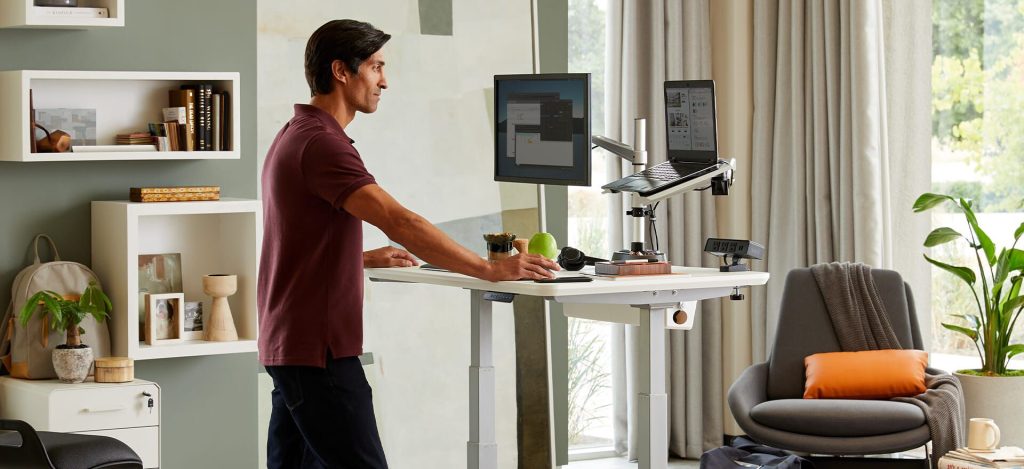Height Adjustable Desks, Standing Desk Converters, Standing Desks
Improving Posture with Standing Desks
Are you tired of sitting all day and experiencing back pain? Look no further! In this article, we will explore the benefits of using standing desks to improve your posture and overall well-being. Discover how standing while working can alleviate backaches and promote better spinal alignment. Say goodbye to slouching and hello to a healthier posture with the help of standing desks!
The Importance of Good Posture
Definition of good posture
Good posture refers to the correct alignment of the body while standing, sitting, or lying down. It involves the proper positioning of the spine, joints, and muscles, allowing for optimal function and minimizing strain on the body. Maintaining good posture is essential for overall health and wellbeing.
Benefits of good posture
Having good posture offers numerous benefits to your physical and mental wellbeing. Correct alignment of your body helps distribute weight evenly, reducing stress on muscles and joints. This can prevent or alleviate back, neck, and shoulder pain caused by poor posture. Additionally, good posture promotes proper organ function and improves circulation, leading to increased energy levels and improved productivity.
Dangers of poor posture
On the other hand, poor posture can have detrimental effects on your health. Slouching, hunching, and slumping can cause muscle imbalances and put excessive strain on certain areas of the body. This can lead to chronic pain, fatigue, and decreased mobility. Poor posture can also contribute to problems such as headaches, decreased lung capacity, and digestive issues. It is crucial to address and correct poor posture to avoid these potential dangers.
Introduction to Standing Desks
Definition of standing desks
Standing desks are workstations that allow individuals to work while standing or sitting at an elevated height. They provide an alternative to traditional sitting desks, offering the flexibility to change positions throughout the day. Standing desks are designed to promote better posture, reduce sedentary behavior, and improve overall health.
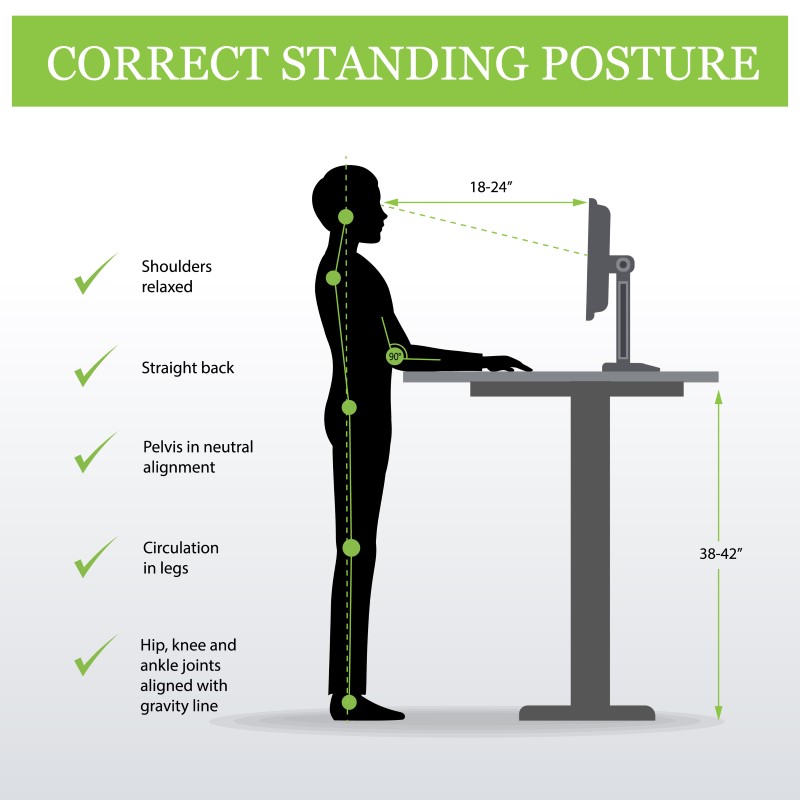
Rise in popularity
In recent years, standing desks have gained popularity as more people become aware of the harmful effects of prolonged sitting. Studies have shown that excessive sitting can lead to a sedentary lifestyle, increasing the risk of obesity, diabetes, cardiovascular diseases, and even premature death. As a result, individuals are seeking healthier alternatives, with standing desks emerging as a popular solution.
Different types of standing desks
There are various types of standing desks available, catering to different needs and preferences. Some standing desks are manually adjustable, allowing you to change the height to your desired position. Others are electronically controlled, making height adjustments effortless with the push of a button. Additionally, there are desk converters that can be placed on top of your existing desk, transforming it into a standing desk. The wide range of options ensures that there is a standing desk suitable for everyone.
Ergonomics and Posture
Link between ergonomics and posture
Ergonomics and posture are closely interconnected, as ergonomics focuses on creating a comfortable and efficient work environment that supports proper body alignment. By optimizing the ergonomics of your workspace, you can significantly improve your posture and reduce the risk of musculoskeletal disorders.
Understanding ergonomics in the workplace
Ergonomics in the workplace refers to the design and arrangement of furniture, equipment, and tools to fit the worker’s needs and promote productivity while minimizing the risk of injury. Proper ergonomics involves ensuring that your workspace is set up in a way that encourages good posture, reduces strain on the body, and promotes movement.
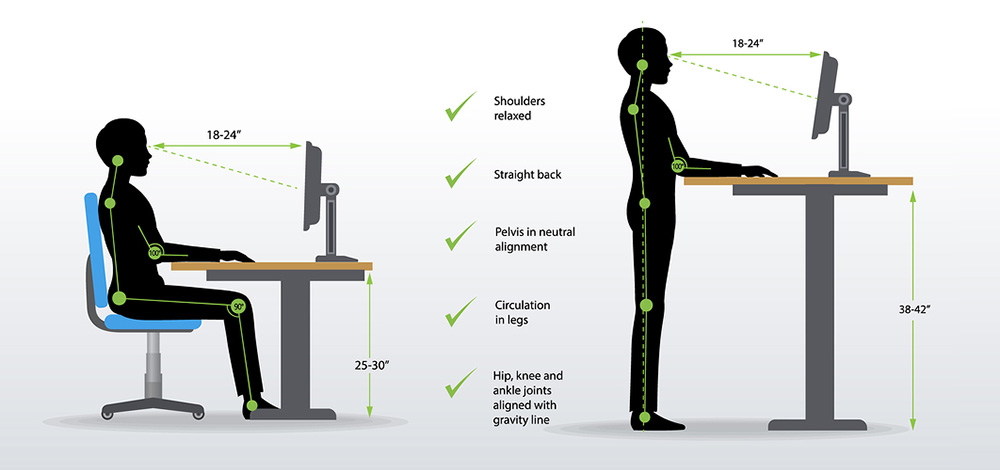
Ergonomic guidelines for standing desk setup
When setting up your standing desk, there are a few ergonomic guidelines to follow to ensure optimal posture and comfort. First, adjust the desk height so that your elbows are at a 90-degree angle when typing. This helps promote a neutral wrist position and prevents strain on the wrists and forearms. Additionally, position your monitor at eye level to avoid tilting your head up or down, which can strain the neck and lead to discomfort. Lastly, position your keyboard and mouse close to your body to prevent reaching and unnecessary strain on the shoulders and arms.
Adjusting Your Standing Desk
Finding the ideal desk height
Finding the ideal desk height is crucial for maintaining good posture and preventing strain on your body. To determine the correct height, stand with your elbows at a 90-degree angle and adjust the desk until your forearms are parallel to the floor. This allows for a comfortable and natural position for typing and working.
Positioning your monitor
Proper positioning of your monitor is essential for maintaining good posture and preventing neck and eye strain. Position the top of your monitor at or slightly below eye level, ensuring that your gaze is directed straight ahead. Avoid tilting your head up or down to view the screen, as this can lead to discomfort and muscular imbalances.
Keyboard and mouse placement
positioning your keyboard and mouse correctly is crucial to prevent strain on your wrists, shoulders, and arms. Keep your keyboard directly in front of you and at a height where your elbows are bent at a 90-degree angle. Place your mouse close to the keyboard, preferably at the same height, to avoid reaching and unnecessary strain on the shoulder and arm muscles.
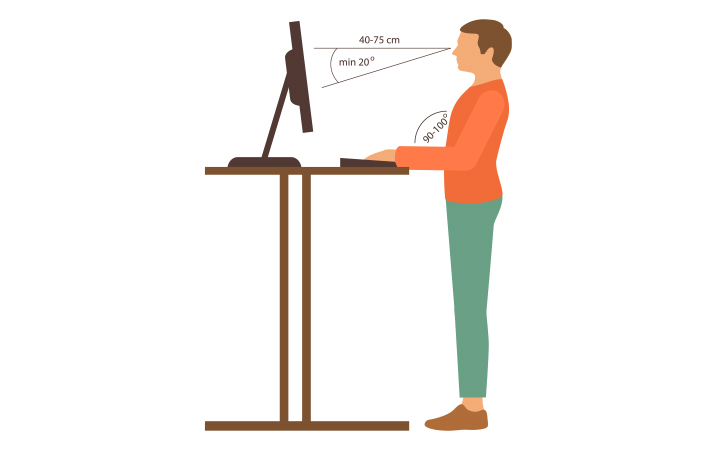
Importance of a footrest
Using a footrest can help maintain good posture and reduce strain on the lower back and legs. Adjust the footrest to a height that allows your feet to rest flat on it, with your knees at a 90-degree angle. This helps improve circulation, relieves pressure on the feet, and promotes proper alignment of the spine.
Maintaining Proper Body Alignment
Aligning your head and neck
Maintaining proper alignment of your head and neck is crucial for good posture. Imagine a string attached to the top of your head, gently pulling it upward. This helps align your head with your spine, preventing forward head posture and strain on the neck muscles. Avoid tilting your head forward or backward, as this can lead to muscle imbalances and discomfort.
Maintaining a neutral spine
A neutral spine is essential for maintaining good posture and preventing back pain. When standing, imagine a straight line passing through your earlobe, shoulder, hip, knee, and ankle. This alignment helps distribute weight evenly and reduces strain on the spine. When sitting, ensure that your back is supported by the chair and avoid slumping or rounding your shoulders forward.
Positioning your shoulders
Proper positioning of your shoulders is essential for maintaining good posture and preventing shoulder and neck pain. Keep your shoulders relaxed and pulled back slightly, allowing them to be in a natural position. Avoid hunching or rounding your shoulders forward, as this can lead to muscle imbalances and discomfort.

Engaging your core muscles
Engaging your core muscles is key to maintaining good posture and reducing strain on your spine. Strong core muscles provide stability and support for the spine, promoting a neutral posture. To engage your core, imagine gently pulling your navel toward your spine without holding your breath. This helps activate the deep abdominal muscles and supports proper alignment of the spine.
Promoting Movement and Stretching
Benefits of movement
Incorporating movement into your workday offers numerous benefits for your overall health and posture. Regular movement helps prevent muscle stiffness, improves blood circulation, and reduces the risk of developing conditions such as deep vein thrombosis. Additionally, movement keeps your muscles active, preventing muscle imbalances and maintaining flexibility.
Incorporating stretching breaks
Taking regular stretching breaks throughout the day can help alleviate muscle tension and improve posture. Simple stretching exercises, such as neck rolls, shoulder stretches, and side bends, can help release tension and promote flexibility. Aim to stretch for a few minutes every hour to counteract the effects of prolonged standing or sitting.
Exercises to improve posture
In addition to stretching, specific exercises can target the muscles responsible for maintaining good posture. Strengthening exercises for the back, core, and shoulder muscles can help improve posture and reduce the risk of developing muscle imbalances. Exercises such as planks, back extensions, and shoulder retractions are effective in promoting a strong and balanced musculoskeletal system.
Avoiding Common Posture Mistakes
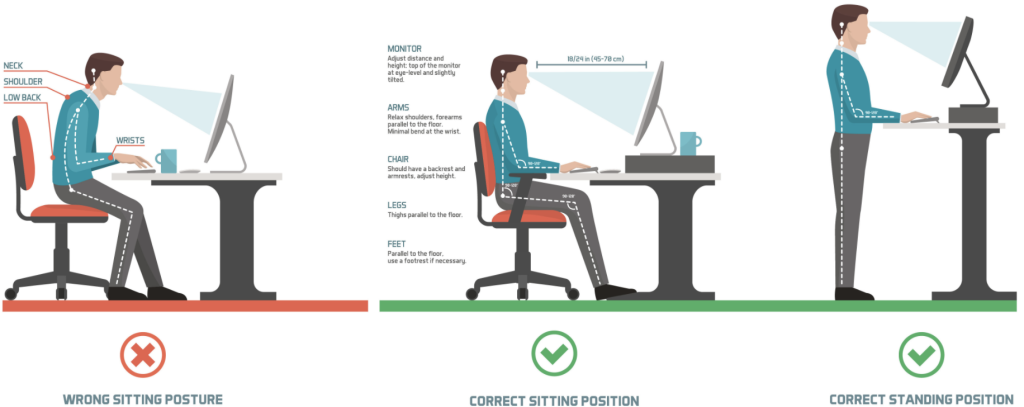
Leaning on your desk
Leaning on your desk while standing or sitting can disrupt your posture and lead to strain on the neck, shoulders, and back. It is important to avoid leaning or resting your upper body on the desk. Instead, maintain an upright position with your shoulders relaxed and your weight evenly distributed through your feet.
Locking your knees
Locking your knees while standing can put unnecessary strain on the joints and disrupt your posture. Keep a slight bend in your knees to distribute your weight evenly and maintain stability. This helps prevent discomfort and promotes proper alignment of the spine.
Slouching or hunching
Slouching or hunching, whether standing or sitting, is a common posture mistake that can lead to muscle imbalances and discomfort. Practice sitting or standing up straight, keeping your shoulders relaxed and your spine aligned. Repeatedly remind yourself to maintain good posture until it becomes a habit.
Prolonged standing
While standing can be beneficial for posture, prolonged standing without breaks can lead to muscle fatigue and discomfort. It is important to incorporate regular breaks and alternate between sitting and standing positions to prevent overexertion of the muscles. Utilize your standing desk to switch between positions throughout the day to promote movement and reduce the risk of developing musculoskeletal issues.
Using Supportive Accessories
Choosing the right anti-fatigue mat
When using a standing desk, an anti-fatigue mat can provide support and cushioning for your feet. Look for a mat that is thick enough to provide cushioning, yet not too soft that it compromises stability. A good anti-fatigue mat helps reduce fatigue, supports proper posture, and provides comfort during prolonged standing.
Utilizing ergonomic chairs
Even with a standing desk, it is important to have a supportive chair for periods of sitting. An ergonomic chair should have adjustable height, lumbar support, and a comfortable seat cushion. When sitting, ensure that your feet are flat on the floor and that your knees are at a 90-degree angle. This helps maintain proper posture and reduces strain on the lower back and legs.
Using lumbar supports
Lumbar supports, such as pillows or cushions, can provide additional support for the lower back when sitting. They help maintain the natural curve of the lower spine, reducing the risk of slouching and promoting good posture. Choose a lumbar support that fits the curvature of your lower back and adjust it to your comfort level.
Implementing standing desk mats or balance boards
To further engage your muscles and promote movement while standing, consider using standing desk mats or balance boards. These accessories provide a slightly unstable surface, forcing your muscles to work actively to maintain balance. This helps improve core strength and stability while reducing muscle fatigue and promoting good posture.
Taking Breaks and Alternating Positions
Importance of taking regular breaks
Taking regular breaks throughout the workday is essential for maintaining good posture and overall health. Avoiding prolonged periods of sitting or standing reduces strain on the body and decreases the risk of developing musculoskeletal issues. Aim to take short breaks every hour to stretch, move, and rest your body.
Alternating between sitting and standing
The key to maintaining good posture is to alternate between sitting and standing positions throughout the day. While standing desks offer the flexibility to stand, it is equally important to give your body the opportunity to sit and rest. Find a balance that works for you, transitioning between sitting and standing every 30 minutes to an hour.
Ideas for incorporating movement into the workday
Incorporating movement into your workday can be enjoyable and beneficial for both your posture and overall wellbeing. Some ideas to keep your body active include taking short walks during breaks, stretching at your desk, using a stability ball as a chair for short periods, and incorporating simple exercises, such as squats or lunges, into your breaks. These activities help promote blood circulation, relieve muscle tension, and improve posture.
Incorporating Other Posture-Improving Strategies
Strengthening exercises for postural muscles
Specific strengthening exercises targeting the postural muscles can significantly improve posture over time. Exercises such as rows, deadlifts, and planks strengthen the muscles in the back, core, and shoulders, preventing imbalances and promoting an upright posture. Consult a professional trainer or physiotherapist to develop a personalized exercise routine that targets your specific postural needs.
Yoga and Pilates for improved posture
Yoga and Pilates are holistic exercise practices that focus on body awareness, balance, and strengthening the core and postural muscles. These exercises promote flexibility, balance, and alignment, helping improve posture and reduce the risk of developing muscle imbalances. Attending regular yoga or Pilates classes can be beneficial for overall body posture and wellbeing.
Maintaining a healthy body weight
Maintaining a healthy body weight is important for overall health, including posture. Excess weight can put strain on the joints, leading to poor alignment and posture. A balanced diet and regular exercise can help you achieve and maintain a healthy weight, reducing the risk of developing posture-related issues.
Seeking professional help if needed
If you are experiencing persistent pain or have concerns about your posture, it may be beneficial to seek professional help. Physiotherapists, chiropractors, and ergonomics specialists can assess your posture, identify areas of concern, and provide personalized recommendations and treatments to improve your posture and overall wellbeing.
In conclusion, good posture is essential for overall health and wellbeing. Standing desks offer an effective solution for improving posture, reducing the risks associated with prolonged sitting, and promoting movement in the workplace. By following ergonomic guidelines, adjusting your standing desk properly, maintaining proper body alignment, promoting movement and stretching, avoiding common posture mistakes, using supportive accessories, and incorporating other posture-improving strategies, you can significantly improve your posture and overall health. Remember to take regular breaks, alternate between sitting and standing, and seek professional help if needed to ensure optimal posture and wellbeing.


